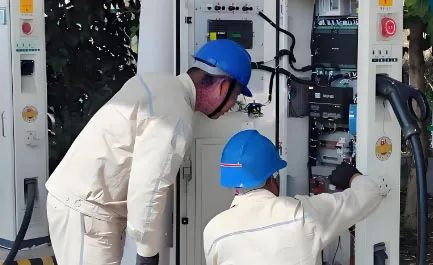After understanding the market development of charging pile.- [About Electric Vehicle Charging Pile – Market Development Situation],Follow us as we take a deeper look at the inner workings of a charging post, which will help you make better choices regarding how to choose a charging station.
Today, we’ll start by discussing charging modules and their development trends.
1. Introduction to Charging Modules
Based on current type, existing ev charging modules include AC/DC charging modules, DC/DC charging modules, and bi-directional V2G charging modules. AC/DC modules are used in unidirectional electeic car charging piles, making them the most widely and frequently applied charging module. DC/DC modules are applied in scenarios like solar PV charging batteries, and battery-to-vehicle charging, commonly found in solar-storage-charging projects or storage-charging projects. V2G charging modules are designed to address future needs for vehicle-grid interaction or bi-directional charging for energy stations.
2. Introduction to Charging Module Development Trends
With the widespread adoption of electric vehicles, simple charging piles clearly won’t be enough to support their large-scale development. The charging network technical route has become a consensus in the new energy vehicle charging industry. Building charging Stations is simple, but building a charging network is highly complex. A charging network is an inter-industry and inter-disciplinary ecosystem, involving at least 10 technical fields such as power electronics, dispatch control, big data, cloud platforms, artificial intelligence, industrial internet, substation distribution, intelligent environmental control, system integration, and intelligent operation and maintenance. The deep integration of these technologies is essential to ensure the completeness of the charging network system.
The core technical barrier for charging modules lies in their topology design and integration capabilities. Key components of charging modules include power devices, magnetic components, resistors, capacitors, chips, and PCBs. When a charging module operates, three-phase AC power is rectified by an active power factor correction (PFC) circuit and then converted into DC power for the DC/DC conversion circuit. The software algorithms of the controller act on semiconductor power switches through drive circuits, thereby controlling the charging module’s output voltage and current to charge the battery pack. The internal structure of charging modules is complex, with a variety of components within a single product. The topology design directly determines the product’s efficiency and performance, while the heat dissipation structure design determines its heat dissipation efficiency, both having high technical thresholds.
As a power electronic product with high technical barriers, achieving high quality in charging modules requires considering numerous parameters, such as volume, mass, heat dissipation method, output voltage, current, efficiency, power density, noise, operating temperature, and standby loss. Previously, charging piles had lower power and quality, so the demands on charging modules were not high. However, under the trend of high-power charging, low-quality charging modules can lead to significant problems during the subsequent operation phase of charging piles, increasing long-term operation and maintenance costs. Therefore, charging pile manufacturers are expected to further raise their quality requirements for charging modules, placing higher demands on the technical capabilities of charging module manufacturers.
That concludes today’s sharing on EV charging modules. We will share more detailed content later on these topics:
- Charging module standardization
- Development towards higher power charging modules
- Diversification of heat dissipation methods
- High current and high voltage technologies
- Increasing reliability requirements
- V2G bi-directional charging technology
- Intelligent operation and maintenance
Post time: May-21-2025





